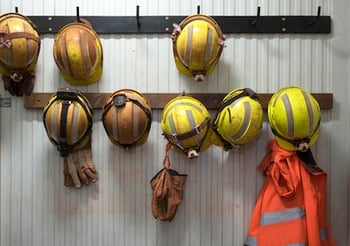How API 752 Enhances Worker Safety in Process Areas
In the oil and gas industry, there are no federal laws or regulations that control what precautions a facility has to take to maintain a protective environment in the event of an explosion on their site. (OSHA dictates a Process Hazard Analysis every five years, but leaves the methods of fulfilling that open to interpretation.)
 For guidance on safety, Oil and Gas companies and Petrochemical facilities typically follow the recommended practices (RP) of the American Petroleum Institute, or API. These guidelines are abbreviated as API RP, and they cover not only standards regarding protection during blast events, but also a myriad of other topics and events that its member companies across the globe must plan for.
For guidance on safety, Oil and Gas companies and Petrochemical facilities typically follow the recommended practices (RP) of the American Petroleum Institute, or API. These guidelines are abbreviated as API RP, and they cover not only standards regarding protection during blast events, but also a myriad of other topics and events that its member companies across the globe must plan for.
What is the API?
To understand its recommended practices, you should first know what or who the API is. The API started as a group of U.S. oil companies that agreed to work together with the government to represent the industry after World War I. The API was established in 1919.
The American Petroleum Institute is a national trade association representing all facets of the natural gas and oil industry. They now promote safety globally and across the industry and they influence public policy in the U.S. on behalf of the oil and natural gas industry.
Which API RP Cover Blast-Resistant Buildings?
There are two recommended practices that cover blast-resistant buildings - API RP 752 and API RP 753.
API 752
The first RP that was developed concerning blast-resistant structures was API RP 752, released in 1995. It deals with the management of hazards associated with the location of permanent, occupied buildings in process areas. It is currently in its third edition, released in 2009.
API 753
The next RP developed was API RP 753, released in 2007. It also deals with the management of hazards in occupied buildings of process areas, but it is in regard to temporary or portable buildings.
Both API 752 and API 753 have been reviewed and revised over the years, it’s important to note that API 752 existed even before such tragedies as the Texas City refinery explosion, but as a fluid document, it was revised to better protect those who work in hazardous areas in the petrochemical industry.
Why Are API 752/753 Important?
Without a formal regulatory board in place, recommended practices like these give companies guidelines to follow. They aren’t meant to fit into a template that tells all facilities how to keep their employees safe, but rather are meant to facilitate safe operating practices when assessments are conducted. So, they don’t replace the need for sound engineering, or safe operating practices, but complement them.
How Are API 752 and API 753 Similar? How Are They Different?
The two recommended practices are similar in that they are both meant to ensure the design, construction, installation, and maintenance of buildings will protect occupants against potential hazards.
Their difference lies in whether the structure is intended to be portable or temporary, or if it can be considered a permanent structure.
Minimizing Personnel in Classified Areas
It’s important to note that API 752 and 753 both mention that occupied structures in hazardous areas should be minimized. In layman's terms, this simply means that there should not be employees working in a hazardous area that don’t need to be in a hazardous area.
So, priority one is to minimize the use of buildings that are intended for occupancy. If the work being done in that building could be located away from the hazard, that should be done first.
There will always be some areas though that are so remote that moving all occupied buildings away simply isn't feasible. And there will always be some personnel that are needed in process areas. To determine the balance between locating personnel onsite vs bussing them off, try out our interactive cost calculator.
What Are Occupied Buildings?
A building can be considered occupied if there are personnel assigned to it, or if there’s a recurring function that draws groups of employees.
A few examples of occupied buildings:
- Control rooms
- Changing rooms or locker rooms
- Conference rooms
- Shelters-in-place
- Laboratories
- Offices
- Warehouses
If a building has a roof, but no walls, it wouldn’t be an occupied building. Examples of this are structures like bus stops, covered walks, and outdoor smoking areas.
Other buildings not considered occupied are those that don’t have personnel assigned and only have personnel in them intermittently.
A Facility Siting Study would help clarify, on a case by case basis, any confusion over whether or not a structure is considered occupied.
What Do API 752 and API 753 Say About a Facility Siting Study?
The recommended practices outline which buildings should be evaluated in a Facility Siting Study, and they require that mitigation plans for any issues uncovered in a study are documented, implemented, effective and that they are in continuous use as long as the building is in use.
How is Assessment Approached?
There are three approaches that owners or operators may take to building siting evaluations.
- Consequence-Based - takes into consideration the impact of an explosion, fire, or toxic scenario.
- Risk-Based - this is quantitative and considers the consequences and the likelihood of explosions, fires or toxic events.
- Spacing Tables - this approach uses established tables to determine minimum distances between equipment where hazards may occur and buildings that are intended for occupancy.
Owners or operators may use one or more of these approaches to evaluate process areas for safety. The facility siting study should actually be performed by a third-party team that is competent in analytical methods. This could include, but isn’t limited to:
- Hazard identification
- Scenario development
- Flammable/toxic gases
- Fire/explosion modeling
- Blast response of structures
- Quantitative risk assessment techniques
API 752 / 753 and Existing Buildings
The evaluation will reveal if existing buildings fail to meet evaluation criteria and will prioritize their mitigation. Prioritization may be based on some of the following:
- Combination of possible damage and occupancy
- Risk
- Mitigation options that could be implemented quickly, like
- Relocation of personnel
- The addition of blast-resistant modular buildings
- Mitigation of hazardous windows
When selecting mitigation options facility owners or operators should determine the best way to reduce consequences, or the frequency of scenarios like blast events. They should use a balanced approach that includes passive, active and procedural measures.
What is a VCE?
One of the dominant explosion scenarios used in API 752/753 is the occurrence of vapor cloud explosions, or VCEs, which happen when five conditions are met:
- The release of flammable material
- Material mixes with air to form a flammable cloud
- Flammable cloud grows
- Ignition source comes into contact with the flammable cloud
- Congestion (with or without confinement) accelerates flames
If a VCE scenario is possible, or likely, the blast load on buildings is then calculated. This is what determines how the building will respond. The building response is evaluated based on the degree of damage that will occur.
API 752/753 and Response Level
The recommended practices will not tell you directly which response level a building should conform to. They will simply act as a guide. Owners/operators will need to look at overpressure maps, as well as the potential duration of a blast.
These factors will help a facility owner, along with their analysis team, determine which buildings are located in the most hazardous areas. Facility owners will need to evaluate their mitigation options to decide how to deal with buildings that aren’t a structural match for the area they are located.
Human Vulnerability
Not only will an assessment of the potential damage to buildings tell you the building response, it should also tell you how vulnerable its occupants are to factors like the collapse of the building and debris.
What Other Hazards do API 752 and 753 Cover?
In addition to explosions, API 752 and 753 also evaluate the potential for danger from fire and from toxic material release. Similar to explosions, the document covers siting evaluations for both fire and toxins, as well as the approaches used to evaluate.
It analyzes the factors, effects and potential vulnerabilities in the same way that it does for blast events, but also touches on shelters-in-place and evacuation. Lastly, the determination of mitigation options is outlined for each hazard type.
What Action Should You Take?
These recommended practices should provide a framework and guidance for managing onsite risks. Understanding the basics outlined here is the first step toward managing a safe environment and ensuring a minimized level of risk and liability.
RedGuard, as an industry leader in safety, can help you in a few ways. We may be known for blast-resistant buildings, but that's not all we do. If it's time to schedule a third-party Facility Siting Study, our engineering team can coordinate with you to determine which evaluation you need.
And second, if you have had a Facility Siting Study performed, but you'd like someone outside your organization to help determine what mitigation options are best, we can help with that too.
If a Facility Siting Study is your next step, take a look at our preparation checklist.
Carreen Gibbons
Carreen Gibbons is the Communications Specialist at RedGuard. With a natural curiosity toward technical subjects and a love of learning new things, she writes content for the SiteBox Storage and RedGuard websites and spends her days learning new things about the industries that the companies serve.





